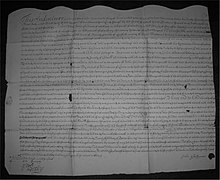Indenture

An indenture is a legal
indentured servant
status, and in modern usage, it is an instrument used for commercial debt or real estate transaction.
Historical usage


An indenture is a legal
indentured labour or a term of apprenticeship but also for certain land transactions. The term comes from the medieval English "indenture of retainer"[1]—a legal contract written in duplicate on the same sheet, with the copies separated by cutting along a jagged (toothed, hence the term "indenture") line so that the teeth of the two parts could later be refitted to confirm authenticity (chirograph).[2] Each party to the deed would then retain a part. When the agreement was made before a court of law a tripartite indenture was made, with the third piece kept at the court. The term is used for any kind of deed executed by more than one party, in contrast to a deed poll which is made by one individual. In the case of bonds
, the indenture shows the pledge, promises, representations and covenants of the issuing party.
Although other evidence indicates that the method has been in use from around the year 1000, the earliest surviving examples in
Pinley, Warwickshire, is held.[4]
In the early history of the United States, many European immigrants served a period of indentured labour in order to pay the cost of their transportation. This practice was common during the 17th and 18th centuries, where over half of immigrants worked off an average of three years' servitude.
Modern usage
Bond indenture (also trust indenture or deed of trust) is a
maturity date, convertibility, pledge, promises, representations, covenants, and other terms of the bond offering. When the offering memorandum
is prepared in advance of marketing a bond, the indenture will typically be summarised in the "description of notes" section.
In the United States, public debt offerings in excess of $10 million require the use of an indenture of trust under the
principal
payments to dealing with the issuer's default, if any occurs.
See also
- Corporate finance
- Debt security
- Debt bondage
- Debenture
- Indentured servant
- Indian indenture system
- Irish slaves myth
- Prospectus
- Securities law
- Slavery
- Blackbirding
References
- ^ a b Morgan, Kenneth O. (2001). "The Early Middle Ages". The Oxford History of Britain. Oxford, England: Oxford University Press. p. 126.
- ^ See for example Brown, M.P., A Guide To Western Historical Scripts From Antiquity to 1600, British Library, 1990, pp. 78-9.
- ISBN 978-0-316-72648-1.
- ^ "Catalogue". Item details SC 8/333/E1104. National Archives. Retrieved 2008-03-28.
- ISBN 978-1-58778-769-0.
External links
- English property indenture from 1804
- Wisconsin Health and Educational Facilities Authorities Revenue bonds
- First international Festival of indenture : http://www.potomitan.info/ki_nov/coolitude_2018.php
